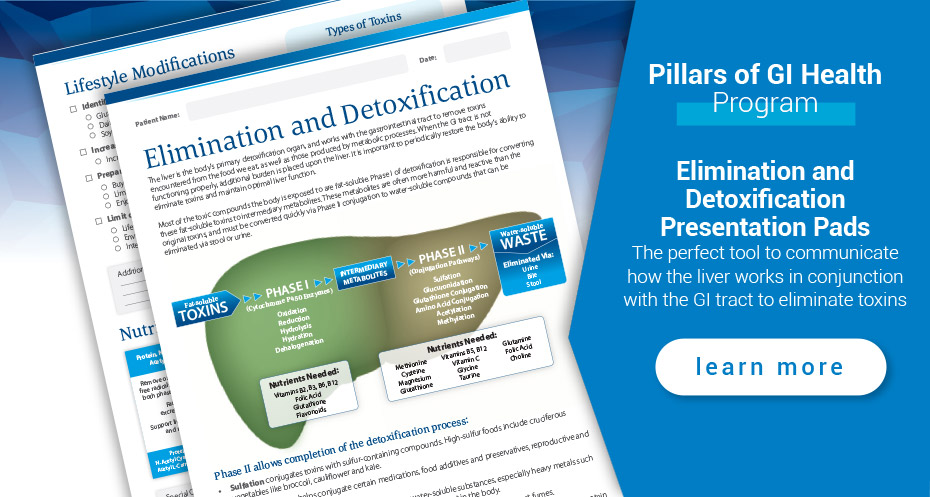Toxins are everywhere, unavoidable and unintentionally ingested, leading to symptoms in your patients like fatigue, brain fog, weakness, confusion, skin problems or gastrointestinal (GI) issues. While the liver, bile and digestive processes naturally balance normal toxic load and remove toxins from the body, gut imbalances or a poor diet can sometimes cause toxins to be reabsorbed instead of removed, leading to repeated filtration by the liver.
Benefits of Detox with Binders
Your patients need your help to stop the harsh cycle of toxin recirculation. This wasteful cycle of absorbing and recirculating toxins only compounds their buildup and allows toxic overload to set in, leaving your patients vulnerable to chronic conditions. To help your patients overcome toxic burden, consider a comprehensive binder solution.
Phase III Elimination
In addition to adequate fiber in the diet, binders provide Phase III elimination support to help reduce hepatic reabsorption. We all know that when the liver processes toxins, they get bound to the bile, which is then bound with insoluble fibers and eliminated via the stool.
Binders can help in this process by selectively absorbing toxins into their structure for elimination from the GI tract. This is important because if there is insufficient insoluble fiber or binders to absorb the bile, the overflow is absorbed in the colon and recirculated via the hepatic portal vein. By reducing the amount of recirculated toxins, binders lessen the load on the liver and kidneys, which speeds up the elimination process.
Gut and Immune Health
Binders can also protect against a highly reactive immune system. Binders provide a shield for the gut lining, limiting the effects of die-off reactions and sweeping away toxins that may be associated with a variety GI conditions (e.g., dysbiosis, SIBO) before they have an opportunity to create immune responses.
Challenges with Traditional Binders
It is not possible to get a single ingredient that will bind to everything. A high-fiber diet and traditional binders may not be enough to trap and remove the many toxins patients encounter in their environment and diet. Binders are not one-size-fits-all: Different binders attach better to different substances, and a binder that works well for some patients can be much less effective for others based on what they eat, their toxic load and other individual characteristics. Also, toxins come in many forms, and some are more difficult to remove than others.
The 3 Best Natural, Broad-Spectrum Binders
In a broad-spectrum binder, the combination of several ingredients can gather and remove a wide array of toxins and debris. Diversity is needed for a more thorough detoxification protocol. A comprehensive protocol will include proven minerals and
natural substances
that can be incorporated to support enhanced clearance of common toxins—like heavy metals, aflatoxins and organic compounds like glyphosate—from the GI tract.1
Activated charcoal, zeolite and shilajit provide many benefits for a safe and healthy detox protocol.
1. Activated Charcoal
Activated charcoal is well-known as one of the best toxin binders available. It has a long history of use in reducing the harmful effects of ingested poisons. Due to its carbon lattice and porous structure, activated charcoal is ideal for trapping and removing a wide array of toxins and other unwelcome substances, preventing absorption by the gut lining and safely carrying toxins out of the body that are bound to its negatively charged surface.2
2. Zeolite
Zeolite is a unique mineral with a high homogeneity of fine matrix crystals. The microscopic structure has a “cup” shape that easily entraps a variety of toxins, holding them securely for safe elimination. Alongside its distinct, microscopic shape, zeolite has an affinity to ionically bind to and adsorb heavy metals.3 It also has a high resistance to degradation in acidic environments and no absorption in the GI tract. These qualities make it an ideal binder for detox protocols.
3. Shilajit
Shilajit is another substance diverse in bioactive compounds, containing over 40 different minerals, including humic and fulvic acids. These types of organic acids have adsorbent properties best known to bind and chelate various noxious agents, including pesticides and organic pollutants like glyphosate. Particularly, the liposomal structure in these organic acids encapsulates hydrophilic and lipophilic compounds, making these vesicles extremely effective binders.4
The Bottom Line
Natural, broad-spectrum binders, like activated charcoal, zeolite and shilajit, offer more comprehensive benefits by binding a wider variety of toxins and removing them from hepatic recirculation. A detoxification protocol that supports safe Phase III elimination helps your
patients who struggle with toxic overload feel better faster.

Joseph Ornelas, PhD, DC holds a PhD from University of Illinois with concentration in Health Economics, an MA degree in Public Policy from the Harris School at the University of Chicago, an MS degree in Health Systems Management from Rush University, and a DC degree from National University of Health Sciences. As a licensed provider and health economist, Dr. Ornelas has published numerous evidence-based clinical practice guidelines, helping to improve quality standards of care and provide value for health care practitioners across several specialty areas.
References
- Vickery A. All about binders and how to use them. Alison Vickery. https://www.alisonvickery.com/blog/all-about-binders-and-how-to-use-them/. Published October 3, 2022. Accessed April 17, 2023.
- Zellner T, Prasa D, Färber E, Hoffmann-Walbeck P, Genser D, Eyer F. The Use of Activated Charcoal to Treat Intoxications. Dtsch Arztebl Int. 2019 May 3;116(18):311-317. doi: 10.3238/arztebl.2019.0311. PMID: 31219028; PMCID: PMC6620762.
- Rollmann LD, Valyocsik EW, Shannon RD (1995). "Zeolite Molecular Sieves". In Murphy DW, Interrante LV (eds.). Inorganic Syntheses: Nonmolecular Solids. Inorganic Syntheses. 30. New York: Wiley & Sons. pp. 227–234.
- Man D, Pisarek I, Braczkowski M, Pytel B, Olchawa R. The impact of humic and fulvic acids on the dynamic properties of liposome membranes: the ESR method. J Liposome Res. 2014 Jun;24(2):106-12. doi: 10.3109/08982104.2013.839998. Epub 2013 Oct 21. PMID: 24144352.




